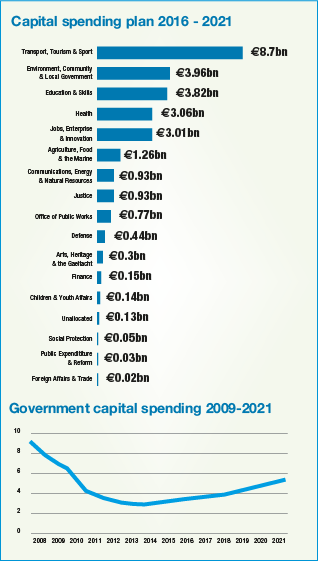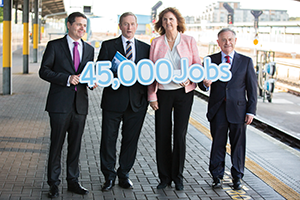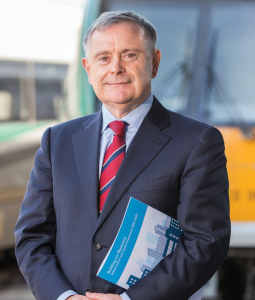A plan for growth
Following the recent publication of the Department of Public Expenditure and Reform’s capital plan for 2016-2021, eolas magazine finds out some of the plan’s key projects.
Announced by Taoiseach, Enda Kenny TD at Dublin’s Heuston train station, it is perhaps no surprise that public sector transport will be a big beneficiary of the €27 billion of additional funding the Irish Government has announced in its new five year capital plan.
The Minister for Public Expenditure and Reform Brendan Howlin TD said that thanks to this large scale investment programme the State’s infrastructure will improve, the economic recovery will be supported and modern fit for purpose buildings will be created to deliver services to Irish citizens. He also confirmed that in total, €42 billion will be invested in Irish infrastructure over the next five years with an additional €14.5 billion coming from commercial semi-states and €500 million from public-private partnerships. The Government estimates that the investment the plan provides for will result in the creation of 45,000 construction jobs but just what are the plans key proposals?
Transport

The government recognises that significant strides have been made since the turn of the century in improving Ireland’s national transport infrastructure and that medium and long-term planning of transport infrastructure is well developed. As such, of the €9.6 billion that has been announced for the transport sector over a period of seven years, €6 billion will be invested in the national, regional and local road network. The remaining €3.6 billion will be invested in public transport.
The largest single project in this area of investment will be the new Metro link in Dublin. The capital plan resurrects the proposed Metro North service and has set a date 2026/2027 for it to begin operation. Metro North will give commuters rail access to Swords, the Airport and the city centre corridor. Work on the line will commence in the final year of the plan in 2021. The first phase of a multi-phase DART expansion programme is also in the pipeline with the extension of the DART line to Balbriggan and the expansion of DART services to Maynooth in the west and Hazelhatch in the southwest.
The department recognises the importance of the DART Underground Project to integrated transport in the Greater Dublin Area over the longer term but in the capital plan they confirm that proposals for this scheme will be “redesigned to provide a lower cost technical solution.” The plan has however confirmed funding for a raft of projects including the completion of the Luas cross city project and the completion of the Dublin city centre resignalling programme.
Of the €6 billion investment planned for Ireland’s roads network, €4.4 billion will be used to ensure the existing network is maintained, while €1.6 billion will be used to fund new projects including the N5 Westport to Turlough project, the M7 Naas to Newbridge bypass widening, the N4 Collooney to Castlebaldwin project and a number of other schemes targeted at removing bottlenecks including the Shannon Crossing Bridge at Killaloe and the Galway by-pass. The capital plan also reaffirms the government’s commitment to co-fund the A5 project through Northern Ireland to Derry, though states that consideration of funding will only occur when planning, timing and costs have been settled by the Northern Irish authorities.
The Government’s Smarter Travel policy is also supported by the capital plan which sets aside €100 million to fund carbon reduction methods in transport, including greenways, with the aim of ensuring the transport sector makes a major contribution towards Ireland’s climate change targets. The Public Private Partnership procurement functions of the National Development Finance Agency will also be transferred to the newly established Transport Infrastructure Ireland. This organisation is now the centre of expertise in Ireland for the planning, delivery and management of capital transport projects and will ensure the project and financial management skills built up during the construction of the major inter-urban motorways and Luas are retained.
Education
Noting the improvements that previous capital plans have made to Ireland’s education sector, this capital plan will provide €3.8 billion in direct Exchequer funding for investment in primary, secondary and third level education facilities. The primary goal of this investment is to meet the demand for additional school places which will impact both the primary and secondary school sectors during the course of this plan.
The investment will fund a further 19,000 primary school places and 43,000 post primary school places by 2022. The funds will also be used to replace existing pre-fab accommodation with permanent classrooms and help to complete the large scale stimulus package already announced. The Government’s Digital Strategy for Schools will also receive a boost as this capital allocation will see €210 million spent on upgrading school ICT and the installation of a robust wireless network in all schools.
Any new schools that are to be built in the next five years will be built with one eye on energy efficiency as the capital plan states that “all new schools and extensions must achieve a top A3 band Building Energy Rating.” A number of factors have to be considered in the establishment of these schools including, but not limited to, the position of the school to gain maximum exposure to the sun during the day for passive solar heating and natural daylight, the installation of energy efficient boilers, individual room temperature controls and insulation levels to minimise heat requirement and the installation of shut off taps and rain water recovery for flushing dual flush toilets.
As for third level education, the capital plan has allocated an extra €110 million for investment in this sector and there is also a commitment to fund Higher Education Research Activities.
Health care

The capital plan includes over €3 billion for investment in health infrastructure that the government hopes will start a long-term programme of transformation of health care facilities across the country. The key areas of focus for the capital plan are: children and maternity; mental health; cancer care; social, community and primary care and a system wide investment in ICT.
The largest of the projects the capital plan will support is the National Children’s Hospital at St James’s Hospital, with satellite centres at Blanchardstown and Tallaght. The project will bring together the three existing children’s hospitals in Dublin into one entity on one campus. The reorganisation of national maternity services will be supported by the relocation of the National Maternity Hospital to St. Vincent’s campus and the transfer of the Rotunda, the Coombe and Limerick maternity hospitals to Connolly Hospital, St James’s Hospital and University Hospital Limerick respectively. However no date has been set for the relocations with the plan simply stating that the facilities will move “towards the later years of the plan.”
Recognising that mental health issues are a growing health and social issue, the capital plan promises investment in the establishment of the new National Forensic Mental Health Services facility in Portrane that will replace the Central Mental Hospital. Work will also start on new specialist intensive care rehabilitation units at Galway, Cork and Portrane within the next five years. The plan also confirms support for new cancer care departments at Cork University Hospital and University Hospital Galway as well as further investment in existing facilities at Beaumont Hospital.
The development of care in the community is also an important part of the plan, with the announcement that 80 new primary care facilities will be provided right across the country, building on the 44 developed since 2011. The facilities, which will be provided for through a combination of direct state funding, public-private partnerships and operational leasing, will house GP and community nursing teams. They will also offer services including physiotherapy, social work, counselling, and occupational therapy. A €300 million investment in the replacement, upgrade and refurbishment of long-term care facilities for older people and people with disabilities has also been announced.
Housing
Another of the capital plan’s priorities is social housing. The plan acknowledges that Ireland has significant supply issues in the housing market in general, particularly in the major urban centres, which the government blames on “legacy issues from the banking crisis.” In response to this, the capital plan has guaranteed €3 billion to create an additional 35,000 housing units between now and 2020. These units will be delivered through a combination of new builds, acquisition and refurbishment of vacant dwellings with a further 1,500 social housing units being delivered through PPPs projects.
Criticism
Perhaps unsurprisingly in an election year, the government’s capital plan has been met with some criticism. It has in some quarters been described as ‘re-gifting spree’ with commentators noting that many of the projects announced in the plan like the Childrens Hospital and the Metro North Service have been announced previously. There has also been criticism of the heavy reliance on PPPs throughout the plan with Fianna Fáil’s public expenditure spokesman, Seán Fleming TD noting that there was no guarantee the government would be able to secure the necessary investment needed to deliver the promised projects.
With the plan now public it remains to be seen just how much of it is delivered over the course of the next five years.






